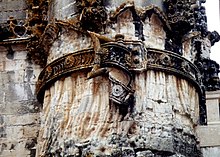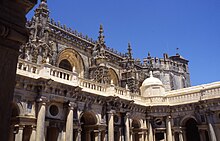Convento de Cristo
| Christ Monastery in Tomar | |
|---|---|
|
UNESCO world heritage |
|

|
|
| Monastery church Convento de Cristo |
|
| National territory: |
|
| Type: | Culture |
| Criteria : | i, vi |
| Reference No .: | 265 |
| UNESCO region : | Europe and North America |
| History of enrollment | |
| Enrollment: | 1983 (session 7) |
The Convento de Cristo (German Christ Monastery ) in Tomar , Portugal , is a former fortified monastery complex founded by Knights Templar in 1162 . Its centerpiece is still the old round church , which houses another octagonal building inside. The model for the building, as can be seen from the number combinations used, was clearly the Holy Sepulcher rotunda in Jerusalem. The monastery complex has been a UNESCO World Heritage Site since 1983 . After the Knights Templar was dissolved by Pope Clement V in 1312 , it became the property of the newly founded order of the Knights of Christ in Portugal .
In 1159 the Order of the Knights Templar received the area around Tomar, about 130 km north of Lisbon and 135 km south of Coimbra, from the first Portuguese king Dom Afonso Henriques . The knights returning from the successful crusades should settle here and support the king in the Reconquista .
After the castle ( Castelo de Cera ) fell into disrepair, it was decided to build a new castle in a more strategic location on the Rio Nabão river. It was on the way between the then capital Coimbra and Santarém .
history
In 1160 the building of the castle (Castelo de Tomar) was started by the Grand Master of the Templar Order Gualdim Pais , because he had recognized that the knightly castle Ceras in the valley of the Nabão river was subject to a violent onslaught by the Arabs, whose attack he expected. wouldn't withstand. He gave the new castle on the mountain the name of the nearby Tomar River. The Arab armies under Abu Jakub Yussef could not take the castle.
Construction work on the cloister within the castle complex began in 1162 . Under Heinrich the Navigator , the construction of another cloister between the choir and the castle began. Inside the castle walls there was also a small community of female Templars called Santa Maria do Castelo, believed to have existed at the end of the 13th century.
In 1484 the cloister and the Christ Knights Church were built under the grand master and future Portuguese king Manuel I. The architect was Diogo de Arruda. During the reign of King Manuel (1495 to 1521) the entire castle complex was richly furnished, and the complex was given its shape that still exists today with the typical mixture of Gothic , Baroque and Manueline style elements.
From 1532 the monastery castle was expanded and expanded by the master builder João de Castilho . In 1557 it was redesigned by the architect Diego de Torralva . The completion of the monastery in its current form took place in 1591 by the architect Filipe Terzi . In 1618 construction began on Portaria Real, Casa da Escada and Sala dos Reis by Diogo Marques Lucas . From the 16th to 17th The monastery complex with the monks' cells and a five kilometer long aqueduct date from the 19th century .
Monastery church
The legacy of the Knights Templar is reflected in its dual function as a defensive and sacred building: First a Romanesque central building was built by the Templars in the second half of the 12th century. Seen from the outside, it is a 16-sided polygon with a strong buttress, round windows and a bell tower. The interior is formed by an octagon that is connected to the gallery by arches. The floor plan is based on the Church of the Holy Sepulcher in Jerusalem.
The interior is richly decorated with Gothic and Manueline sculptures and paintings. The paintings come from the workshop of the court painter Manuel I, the Portuguese Jorge Afonso, while the Flame Olivier de Gand and the Spaniard Hernán Muñoz created the sculptures. The work “The Martyrdom of St. Sebastian”, created for the church at the time, now hangs in the Lisbon Museum of Ancient Art ( Museu Nacional de Arte Antiga ).
In the 15th century, under Heinrich the Navigator, a Gothic nave was added to the Romanesque central building. The Romanesque building became the apse of the enlarged church. From 1510 the nave was redesigned in the Manueline style by the Portuguese architect Diogo de Arruda and the Spaniard João de Castilho. The so-called "Janela do Capítulo" (window of the chapter house) combines many typical Manueline motifs: the cross of the Order of Christ, cordage , corals and plant motifs.
A side portal serves as the entrance to the church, which is also richly decorated with Manueline motifs, a virgin with the child and Old Testament prophets.
The Manueline nave is connected to the Romanesque apse by a large arch. Former Manueline choir stalls were destroyed by Napoleonic troops in the early 19th century.
Cloisters
There are a total of eight cloisters that were laid out between the 15th and 16th centuries. Examples are:
- Claustro da Lavagem: Two-storey Gothic cloister, built around 1433 under Henry the Navigator.
- Claustro do Cemitério: Also originated in Heinrich's time. The knights and monks of the monastery were buried here. The remains of Diogo da Gama, brother of Vasco da Gama, rest here in a Manueline tomb (around 1523) .
- Claustro de Santa Bárbara: Built during the 16th century in the Manueline style.
- Claustro dos Filipes: A two-storey cloister with a magnificent baroque fountain. On the second floor, the Spanish King Philip II is said to have been crowned King of Portugal in 1580 .
- Claustro de D. João III: Started under John III. and completed under Philip I. Initially planned by the Spanish architect Diogo de Torralva in 1557, the building was completed by the architect Philipps, the Italian Filippo Terzi. This two-storey cloister connects the dormitory with the church. He is one of the most important examples of mannerism in Portugal. The floors are connected by elegant spiral staircases at the corners of the cloister.
Web links
- Castelo de Tomar. In: Pesquisa Geral - Pesquisa do Patrimonio. Direção Geral do Património Cultural , accessed March 23, 2018 (Portuguese).
Individual evidence
- ↑ Kappler, Anke., Naujokat, Anke .: Jerusalemskirchen: Medieval small architectures based on the model of the Holy Sepulcher . Geymüller Verlag für Architektur, 2011, ISBN 978-3-943164-01-5 .
Coordinates: 39 ° 36 '14 " N , 8 ° 25' 9" W.







